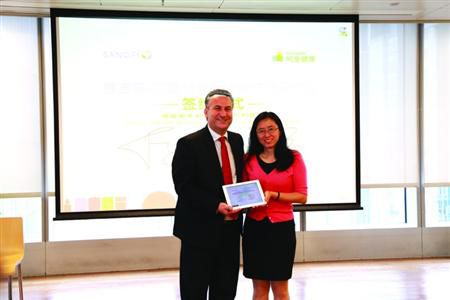Sanofi and Ali Health Alliance form the high point of medical innovation (Photos)


Sanofi China's pharmaceutical operations general manager Jean-Christophe Pointeau (left), Ali Health Vice President Ma Li (right)
In the two years of experiencing explosive growth in 2014 and capital competition in 2015, nowadays, the development and innovation of Internet medical care has entered a more mature and rational period. Many industry giants have chosen “marriage†at this time. Resolutely enter the deep water area of ​​Internet medical innovation.
On June 1st, Sanofi and Ali Health announced the signing of a strategic cooperation framework agreement at Sanofi Asia and China headquarters in Jing'an Temple, Shanghai. The two sides will share high-quality resources in their respective fields and carry out strategic cooperation in various aspects of the medical field. Form a synergy to provide better medical and health services for Chinese patients. According to reports, the two sides will explore the online and offline O2O form, integrate the medical and technical resources of both sides, and build a safe, professional and convenient medical health service network. The collaboration is another innovation after the company's cooperation with another mobile Internet company's health road last year.
As one of the earliest multinational foreign-invested pharmaceutical companies entering China, Sanofi has spared no effort in investing in diversified business innovation. “In order to provide the best solution for healthcare professionals and patients in the mobile medical field, it is necessary to cooperate with professional companies to fully realize the advantages and complement each other.†Pan Zhenke, General Manager of Sanofi China Pharmaceutical Operations (Jean -Christophe Pointeau) firmly believes that extensive cooperation in China is the cornerstone of localization and the key to the success of multinational pharmaceutical companies in a changing market.
Innovation is not a closed door
The breakthrough in research and development of new drugs is often the core of innovation in pharmaceutical companies. Because drug development often involves core technology patents, patient information, and other issues, the process is not understood by most people. At the same time, the development of an innovative drug usually takes ten years and hundreds of millions of dollars in investment. The R&D investment and technical barriers of foreign companies are also in stark contrast to today's Internet technology innovation. It is reported that Sanofi has four R&D headquarters in the world, and its R&D investment in 2015 was about 5.26 billion Euros. Sanofi has established the China R&D Center and the Asia Pacific R&D Headquarters in Shanghai. It has the overall R&D capabilities from drug target research to late clinical trials, and focuses on high-risk diseases such as liver disease, diabetes, cancer and cardiovascular disease in China and Asia Pacific. disease.
“Sinofi will bring more scientific and health management solutions to patients through innovative drugs and services. With the help of Ali Health, we will make full use of Sanofi for the medical industry and diseases with the aim of 'patient first'. In-depth understanding of management, combined with the advantages of Ali's healthy platform data technology, to achieve leap-forward cooperation, to provide scientific and professional medical health services for the majority of patients and their families." Peng Zhenke said frankly: "No partner can solve all problems, we The cooperation with Ali Health is not exclusive. The two sides will use their respective advantages to explore in several important areas including online and offline (O2O). Apparently, Sanofi is no longer satisfied with traditional drug innovation. Develop a long payback period.
In March 2015, the General Office of the State Council issued the National Medical Health Service System Plan (2015-2020), emphasizing the active application of mobile Internet, cloud computing, and Internet of Things technologies to promote health information and smart medical services. In July of that year, the General Office of the State Council issued the “Guiding Opinions on Promoting the Internet + Action Planâ€, proposing “promoting a new model of online medical care; developing Internet-based medical and health servicesâ€. As a company that has been cultivating the Chinese medical market for many years, Sanofi is keen to capture this trend and quickly and flexibly launch the “Alignment†campaign. In October 2015, Sanofi and Health Road announced a strategic cooperation project, Kangsai, targeting mobile mobile medical platforms in the county market, starting with three areas: patient education, grading diagnosis, and disease management. Based on technology, we will create doctor-patient communication and follow-up tools to improve the disease management level of patients with chronic diseases; establish a continuing education platform for county doctors, improve the awareness of basic standardized diagnosis and treatment, and help build a graded diagnosis and treatment system to achieve two-way referral. Up to now, this project has signed 345 county hospitals, and the number of active doctors signed by the project is 8,200, which has covered more than 13,000 patients.
Chronic management:
Internet medical innovation
The "China Chronic Disease Prevention and Control Work Plan" pointed out that "the number of chronic diseases in China is rising rapidly. The number of confirmed patients is 260 million, which is a major public health problem. If it is not controlled in time, it will bring serious social and economic problems." China has nearly 114 million diabetic patients; 290 million cardiovascular patients, 7 million stroke patients and 2.5 million patients with myocardial infarction; 330 million hypertensive patients. Sanofi has always had a product line that is envied by the peers in the fields of chronic diseases such as cardiovascular disease, diabetes, central nervous system diseases and oncology, which has enabled Sanofi to accumulate considerable practical experience in chronic disease management.
Chronic diseases have become a hot spot for Internet medical treatment because of their long duration, complicated etiology, high cost of treatment and frequent communication between doctors and patients. At the same time, they are also the most competitive areas. At present, a number of multinational pharmaceutical companies, including Sanofi, AstraZeneca, Bayer, etc., have been deployed in this field. As an invited guest of the strategic cooperation conference, Ms. Zhang Ning, head nurse of the Department of Endocrinology, Affiliated Drum Tower Hospital of Nanjing University, said: “The management of chronic diseases is a long-term process that requires high-viscosity, high-frequency long-term monitoring of patients. And scientific management; this happens to be in line with the core strengths of mobile internet technology."
"We are increasingly aware that the core of chronic disease management is to establish the patient's own initiative, so that patients understand the harm of the disease, so that they can actively and effectively follow the doctor's advice, take medication on time, and achieve good self-health management. Because many chronic diseases are It is asymptomatic, such as high blood pressure and high blood sugar. But if left unchecked, the risk factors will become long-term malignant events, and eventually even death. So Sanofi hopes that patients have a very good understanding of chronic diseases. Knowing its harmfulness, knowing the effective treatment plan, and implementing it according to this plan. We hope to improve the patient's disease cognition level together with Ali Health," Peng Zhenke said.
Quantum Resonance Magnetic Analyzer:
The electromagnetic wave signals emitted by the human body represent the specific state of the human body, and the emitted electromagnetic wave signals are different under the different conditions of the human body, such as health, sub-health, disease, etc. If we can determine these specific electromagnetic wave signals, we can determine the status of the body's life.
The Quantum Magnetic Resonance Analyzer replaces the need for ultrasonic, nuclear magnetic resonance or radiography for various health related conditions. Holding sensors in your palm simply, health data will be collected within minutes from various body systems. The magnetic resonance analyzer offers new advantages in the field of material analysis. It has been shown that the applicability of such an analyzer exceeds the range of tissue analysis and other medical applications. The magnetic resonance analyzer measures the degree and type of response of a matter under test, and by comparison with reference matter it assists in recognizing deviations from the desired response. The software interface has updated high technology that the operation is more convenient and faster. The main future is 2 languages in software in one machine, both with English and another language.
Quantum magnetic resonance analyzer collect the weak magnetic field sensors of frequency and energy from human body through the hand grip sensor. Through the instrument magnifies and the computer processing ,compare with the disease set up inside the instrument install and standard quantum resonance spectrum, use the Fourier analysis method analysis if the sample wave pattern become chaotic.According to the results, make an analytic judgment for the person in state of Sub-health and primal problem, and put forward the standard advice for preventive treatment.
Quantum Body Analyzer,918 Quantum Analyzer,Quantum Analyzer Price,Quantum Resonance Magnetic Analyzer,Quantum bioresonance analyzer
Shenzhen Guangyang Zhongkang Technology Co., Ltd. , https://www.szlighttherapymachine.com